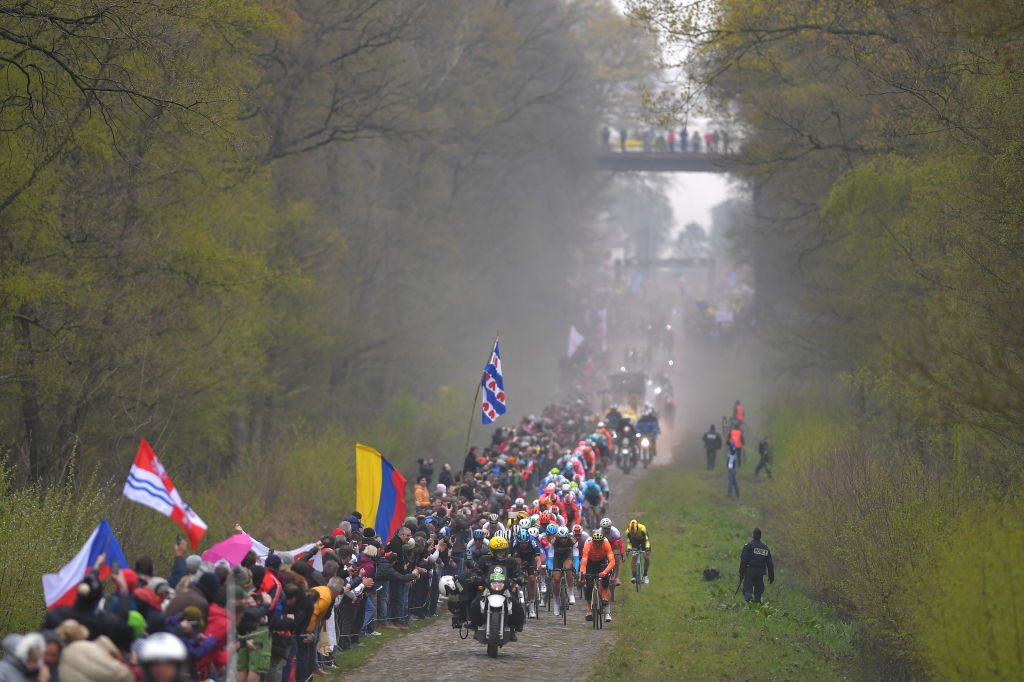
Cobbled Classics contender Matteo Jorgenson (Visma-Lease A Bike) has delivered a strongly worded opinion in favour of the chicane that has been installed at the entrance to the Arenberg Forest sector of pavé on Sunday’s edition of Paris-Roubaix.
The newly introduced chicane is designed to slow the riders at a point where the usual high-speed entry into the forest sector, traditionally one of the crunch moments of Paris-Roubaix but often marred by multiple crashes.
Even before it’s been raced, the chicane, which is more strictly a 180-degree U-turn, has sparked multiple, and varied, arguments both for and against it. Defending Paris-Roubaix champion Mathieu van der Poel (Alpecin-Deceuninck) recently posted a pointed single-line ‘Is this a joke?’ reaction on Twitter, formerly X, to make their feelings plain.
The American’s post, though, is markedly in favour, saying via a post on the same social media network : "Is this what fans want to see? Riders completely covered in blood after sliding face-first at 50mph/80kph on sharp rocks in a forest? I’ll take a couple of turns and some guys sliding out on pavement any day…"
Jorgenson links in his post to a video of the 2016 Paris-Roubaix crash where retired Australian racer Mitch Docker was one of several riders to suffer a major high-speed fall at the start of Arenberg that year. Docker broke his nose amongst other injuries as a result of the pile-up.
A statement from organisers ASO on Wednesday stated that "For safety reasons and following a request from the C.P.A. (Cyclistes Professionnels Associés) association, the Paris-Roubaix organisation is modifying the approach to the Trouée d'Arenberg."
"The route will take a chicane just before the entrance to the sector in order to slow the speed at which the riders enter the sector and limit the risk of crashes on the cobbles."
Known as the Trouée d’Arenberg, the 2.3km sector is well-known to be the most challenging of all in Paris-Roubaix and crashes abound there, with Kasper Asgreen amongst the fallers last year.
Jorgenson himself has ridden Paris-Roubaix once, back in 2021. But after a stunning early Classics season this year, including a victory in Dwars door Vlaanderen, and in the absence of his injured team leader Wout van Aert, the Visma-Lease A Bike rider is expected to be one of the contenders on Sunday.
In the lengthy countdown to the Queen of the Classics, the rider-slowing traffic
furniture has sparked a welter of reactions, with Belgian newspaper Het Laatste Nieuws conducting a vox pop of numerous former and current participants in the race.
“I was one of the riders who asked ASO to intervene,” Tim Declerq (Lidl-Trek), a nine-times Roubaix participant, told the paper.
“It's crazy, the Forest of Wallers [Arenberg] is getting worse year after year. So many careers have been destroyed because of it. Something had to change. Everyone says: cycling should be safer. But as soon as someone comes up with a proposal, the disadvantages are pointed out. That is also typical cycling.”
Declerq estimates that the speed the peloton will now take entering Arenberg will be 30 or 35kmh rather than 70km, and points out that the lack of momentum from the early high speed should cause a drop in the danger levels as well.
Paris-Roubaix podium finisher and Milan-Sanremo winner Jasper Philipsen (Alpecin-Deceuninck) was more cautious about delivering a definitive opinion, telling Het Laatse Nieuws that “Accidents also happen on other sectors. You cannot predict in advance whether a bend for the Forest of Wallers is the right decision.”
Sep Vanmarcke, a former racer and Classics specialist, was much more uncertain of how it will pan out, arguing bluntly “Chicanes will make it even more dangerous. They just have to look at the map and find another way.”
However, he warned about the inherent dangers of Arenberg, saying “It’s an extreme sector. Riders no longer have control over what they are doing.”
“You go in, you get so many shocks and it goes so fast. The shocks are so deep that you can no longer see what you are doing. You can only focus on staying straight and driving straight ahead. If someone next to you loses control, you no longer have a chance.”
Meanwhile on Twitter, formerly X, the number of opinions both for and against continues to rise, with support for Jorgenson’s argument coming from the Norwegian Amund Grondahl Jansen (Jayco-AIUIa).
“Why it’s a good idea: you can reduce speed when on tarmac with much lower risk of crashing than on cobbles;” he posted. “Crashes often occur from 20th backwards as the first riders slow down from entering the cobbles while further back you still enter at 60+. Hitting the brakes is a lottery.”
Yet another unpredictable factor in an event where luck traditionally plays a huge role is the weather. While Sunday is currently set only to be wet late on in the afternoon, with intermittent rainfall in the week leading up to Roubaix, the cobbles will likely already be very slippery regardless.
As for the consequences of Arenberg and its chicane, the full effects will only become clear around 3pm on Sunday afternoon.
Is this what fans want to see? Riders completely covered in blood after sliding face-first at 50mph/80kph on sharp rocks in a forest? I’ll take a couple of turns and some guys sliding out on pavement any day… https://t.co/Xi6OZnZSa9 pic.twitter.com/jNHtu5ndjcApril 4, 2024
Why it’s a good idea: you can reduce speed when on tarmac with much lower risk of crashing than on cobbles. Crashes often occur from 20th backwards as the first riders slow down from entering the cobbles while further back you still enter at 60+. Hitting the brakes is a lottery. https://t.co/FpGTWdbNhPApril 3, 2024
Get unlimited access to all of our coverage of the Spring Classics- including reporting, breaking news and analysis from the Paris-Roubaix. Find out more.







